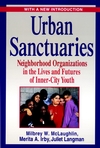 I have been a fan of the work of Milbrey McLaughlin for the past couple of years. I did a posting a while ago of her report called Community Counts, and have occasionally referenced her book writted with Shirley Brice Heath called Identity and Inner-City Youth.
I have been a fan of the work of Milbrey McLaughlin for the past couple of years. I did a posting a while ago of her report called Community Counts, and have occasionally referenced her book writted with Shirley Brice Heath called Identity and Inner-City Youth.Urban Sanctuaries: Neighborhood Organizations in the Lives and Futures of Inner-City Youth is a book which she wrote in 1994. I picked it up a couple of weeks ago at a second hand bookshop in NYC. When I began reading it, I discovered a wealth of information incredibly relevant to youthworkers. (I RECOMMEND this book whole-heartedly!)
McLauglin calls successful youth leaders 'wizards':
"They have created environments in which youth from the tough streets of inner-city neighborhoods can imagine a positive future. Accomplishing what conventional wisdom has often held impossible, these wizards have fashioned organizations that capture urban adolescents' attention, time, and loyalty. They are successful with adolescents many in society dismiss as unreachable or unredeemable." (p.37)
McLauglin observed five common characteristics in these type of leaders:
1. Seeing Potential, Not Pathology. "Successful leaders of inner-city youth organizations have a passionate commitment to young people, particularly to undeserved and disadvantaged youth... Wizards have no hesitation in viewing inner-city youth as valuable assets to society..."
When wizards frame their personal and organizational missions they consider inner-city youth as resources and youth organizations as opportunities to develop these resources. They see potential, not pathology; therefore they design settings to guide youth through the mingled violence and indifference of the inner-city environment and to engage them in the types of learning and experiences that will transform these adolescent boys' and girls' sense of their own abilities and expectations so that they can duck the bullet." (p.96)
2. Focusing on Youth. "...They focus on youth before organization, program, or activity. They see youth organization technology and the models that policymakers focus on and try to replicate only as vehicles for turning commitment into practical reality. Wizards personal agendas contrast with those well-intended leaders whose primary passion is their program or institution." (p.98)
3. A Sense of Efficacy. Wizards' commitment to and focus on inner-city youth is reinforced by a strong sense of personal efficacy. While counteless other youth workers or policymakers stress that 'it is too late for teens,' that 'you have to get them when they are young,' these successful leaders have a firm conviction that they can and do make a difference in the lives of teenage youth from even the bleakest urban settings." (p.100)
4. Giving Back. Part of wizards' consuming commitment to youth results from their wanting to give back what others gave them as they grew up... (they) also hope their adolescents, in turn, will develop a commitment to give opportunities and brighter futures back to others...
The salience to the wizards of giving back explains why these talented, energetic individuals choose to work in a field of notiriously low pay, little or no recognition, and limited upward mobility. All of them see their work as a mission and vocation, not simply a job or even a career in the traditional sense... They are not seeking to move up and out of their positions that bring them into regular contact with youth. (p.101)
5. Authenticity. Each wizard manifests different personality and programmatic interests, with the result that each successful organization has some characteristic that is a special draw for youth. Wizards create programs for musicians, thespians, scholars, athletes, artists, and young people who simply want a supportive group to call their own... The moral here appears to be that one-size-fits-all programming misses adolescents' need to do their own thing, to feel they are pursuing interests and goals they themselves have selected.
The wizards we came to know also demonstrated the authenticity of their commitment through becoming part of their inner-city communities' fabric and soul. (pp.102-103)
No comments:
Post a Comment